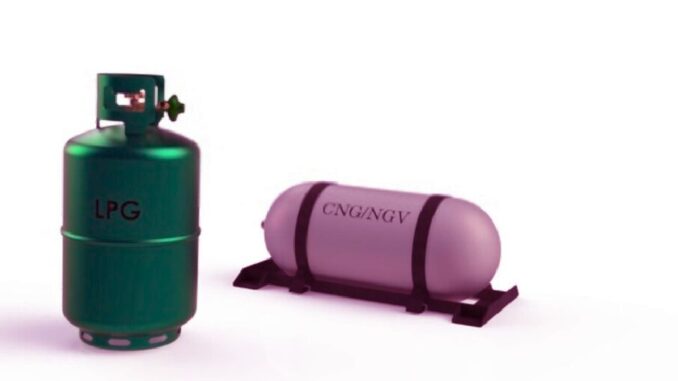
Natural gases are created over hundreds of years, very deep inside the surface of Earth. Extraction of these gases to the surface can be accomplished through the pumping process. Once these gases are extracted to the surface of Earth, they are cleaned and refined to remove the impurities.
There are various by-products of natural gas processing, such as pentane, ethane, propane, pentane, and other hydrocarbons, which weigh more. Natural gases are used in our daily lives in many forms, such as LPG, CNG, etc.
The difference between CNG and LPG and the similarities between these two gases are quite interesting. Let us start with understanding what CNG and LP gases are.
CNG Gas
We may have heard of the acronym CNG quite often, but do we know what this means?
CNG stands for Compressed Natural Gas. CNG is, in fact, a compressed form of pure methane gas. This gas is the gaseous product of petroleum, and during the distillation process, CNG is the first product to be separated.
CNG is made of 93.05% methane, carbon dioxide, nitrogen, propane with traces of ethane. It is also tasteless, odourless, and non-toxic.
This gas is considered an environmentally clean alternate fuel, as its combustion or ignition process releases a lesser percentage of greenhouse gases than other fuels. The one main advantage of CNG is that its octane rating is quite high, which means that this gas offers a high compression ratio and is compliant with modern engines.
LPG Gas
Now that we have explained what CNG gas is, let us explain LPG gas. LPG stands for Liquefied Petroleum Gas. As the name explains, this gas is liquefied – a by-product of crude mining petroleum.
LPG is odourless, colourless, and an extremely flammable explosive gas that weighs twice as much air. It comprises traces of propylene and butylene along with propane mixed with butane. LPG is also called Autogas. Butane or propane are other names of LPG or the Liquified Petroleum Gas.
One main advantage of LPG is that it releases less carbon monoxide, hydrocarbons, and nitrogen oxides. In addition, this gas also maintains an excellent octane rating and aids in engine longevity.
Differences Between CNG and LPG
Though both CNG and LPG are natural gases, these gases have a lot of differences. The following table summarizes the key differences between CNG and LPG:
| CNG | LPG |
| The main use of CNG is as an alternative for fuel in vehicles and automobiles. | This gas has several uses, such as cooking and heating in homes. LPG also has agricultural and industrial uses. |
| CNG is industrially used as a refrigerant and also as automobile fuel. | LPG is commonly called cooking gas, and it is mainly used in restaurants and homes for cooking purposes. |
| The chemical formula for CNG is CH4, and CNG is found only in the gas state.CH4 is also the chemical formula for methane which is what CNG is primarily composed of. | The chemical formula for LPG is C3H8, and LPG can be found either in a gas or liquid state.LPG mainly comprises hydrocarbons that contain three or four carbon atoms. Thus, the normal components of LPG are butane (C4H10) and propane (C3H8). |
| The main component of CNG is methane, and this gas has a low calorific value of 35 to 40 MJ/m3. | LPG mainly comprises butane and propane, and the calorific value of LPG is 90 to 95 MJ/m3. |
| This gas releases relatively lesser quantities of greenhouse gases (as compared to LPG). | Generates relatively huge quantities of carbon dioxide, which is a greenhouse gas; however, this gas is cleaner than gasoline. |
| This gas is considered relatively safe as it dissolves rapidly in the air if it leaks. | This gas is highly flammable since it weighs twice as much as air. Also, if this gas leaks, it will settle to the ground and collect in low lying regions. |
| CNG is usually cheaper than LPG. However, propane generates twice the amount of energy as compared to natural gas. | LPG can be more cost-effective than natural gas, depending upon the local costs (that tend to vary). |
| The primary source of obtaining CNG is methane wells, oil wells, coal wells, and natural gas wells. | The primary source of procuring LPG is through the process of natural gas extraction from reservoirs. |
| CNG has an energy content of 9MJ/L. | LPG has an energy content of 25MJ/L. |
| CNG requires air to gas ratio of 10:1 for proper combustion. | The air to gas ratio for proper combustion of LPG needs to be approximately 25:1. |
| CPG storage pressures can be more than 10 times that of LPG, around 20 – 25 MPa. | LPG pressure is not more than 2 MPa. Thus, if you consider the comparable capacity of cylinders, then LPG cylinders last twice as long. |
Similarities Between LPG and CNG
Now that we have understood the differences between LPG and CNG, let us go through the similarities between both these gases:
- Both CNG and LPG are natural gases that are industrially as well as domestically used. These gases are also used as fuels for automobiles.
- Both these gases are energy sources that are produced domestically; thus, reducing dependence on imported oil.
- Both these gases are used as transposable fuels as they are kept or stored in cylinders or tanks.
- In comparison with diesel and petrol, both CNG and LPG have decreased the emission of greenhouse gases.
Conclusion
It is but natural to wonder which gas is more powerful – LPG or CNG. As already mentioned, CNG only has about 1/3rd of the energy density compared to LPG (propane) with 9MJ/L. In contrast, LPG has an energy density of 25MJ/L respectively. Thus, LPG is a far superior solution for home bottled gas users, coupled with longer-lasting cylinders.
While CNG gas is an excellent choice for fleets that operate out of terminals, the availability and low energy density factors restrict CNG as a choice for cars or home use. The extensive and existing LPG infrastructure makes LPG a better choice for cars.
The high energy density factor of LPG makes this gas an excellent solution for users of home bottled gas, coupled with long-lasting cylinders.

Leave a Reply